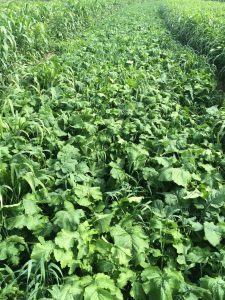Plant Diversity
By Dwayne Beck, Ph.D, Pierre, South Dakota
Dwayne Beck has had more impact and influence on Plains Agriculture in this generation than anyone else we know. As director of the Dakota Lakes Research Farm in Pierre, SD, Dr. Beck has developed his vision of regenerative agriculture in the field and not in a laboratory or a classroom. His practical approach to systems based agriculture is legendary and his candid style of education is refresh-ing to anyone who has heard him speak. Dr. Beck writes here about the Power of Plant Diversity:
 A diverse crop rotation system consists of growing different kinds of crops in planned sequences to take advantage of the power of diversity and reduce overall risk. One of the most important roles of a crop rotation is to mimic the natural water and nutrient cycle while maxi-mizing the amount of sunlight captured. If this is not done, the ecosystem will degrade quickly (erosion, water quality issues, etc.).
A diverse crop rotation system consists of growing different kinds of crops in planned sequences to take advantage of the power of diversity and reduce overall risk. One of the most important roles of a crop rotation is to mimic the natural water and nutrient cycle while maxi-mizing the amount of sunlight captured. If this is not done, the ecosystem will degrade quickly (erosion, water quality issues, etc.).
Historically, rotations have been much more diverse than they are at the pres-ent time. Most of them included phases with perennial crops like pastures and/or alfalfa. Almost all of them had livestock involved. This loss of diversity was due to a myriad of economic driving factors including farm program characteristics; mechanization, development of nitro-gen fertilizer sources and pesticides, and specialization in livestock production. Interest in diversifying crop production systems has increased recently due to many factors. Commodity prices that are low relative to the costs of fertilizer, machinery, labor, and pesticide inputs have led producers to examine means of reducing these costs.
In addition, natural selection pressure resulting from longer histories of tight rotations and mono-cultures have led to species shifts, resistance, and/or changes in pest’s traditional habits that have resulted in yield losses and/or use of higher priced technologies. Proper application of rota-tional planning can increase yields, reduce costs, and improve soil health and fertility. These positive benefits affect whole farm economics by reducing weed, disease, and insect pressure and resistance; spreading workloads to reduce fixed machinery and labor costs; providing more optimum planting and harvesting timing; and di-versifying income and spreading weather risks. Failing to match natural systems has caused much of the environmental issues we face in US agriculture.
 It is over-simplistic to classify rotations as good or bad. Rather it is best to think of rotations as having differing character-istics in terms of their impacts on various aspects of the crop production system used by a particular grower in any given environment. Designing appropriate crop rotations is a mix of art and science. Since all aspects (agronomic, environmental, economic, engineering) must be consid-ered simultaneously, a systems approach is required. For any given situation, there will be a range of rotations that will be agronomically appropriate. Within this range are rotations which have differing characteristics in terms of the risk they pose (market availability, labor or machin-ery requirements, etc.) which may make some more suitable for use in a particular location. Management decisions must be made by individual producers to select the rotation or combination of rotations that is most appropriate for them.
It is over-simplistic to classify rotations as good or bad. Rather it is best to think of rotations as having differing character-istics in terms of their impacts on various aspects of the crop production system used by a particular grower in any given environment. Designing appropriate crop rotations is a mix of art and science. Since all aspects (agronomic, environmental, economic, engineering) must be consid-ered simultaneously, a systems approach is required. For any given situation, there will be a range of rotations that will be agronomically appropriate. Within this range are rotations which have differing characteristics in terms of the risk they pose (market availability, labor or machin-ery requirements, etc.) which may make some more suitable for use in a particular location. Management decisions must be made by individual producers to select the rotation or combination of rotations that is most appropriate for them.
Get more info about Dakota Lakes Research Farm
Additional Links
- 5 Soil Health Principles – In this article, North Dakota soil health expert, Jay Fuhrer does a great job introducing all five of the Principles of Soil Health.
-
Plant Diversity – Jay Furhrer explains why Plant Diversity is important in this 5 minute video clip from the Menoken Farm